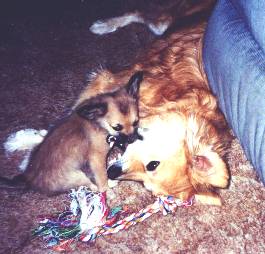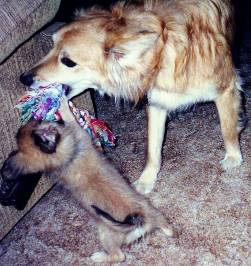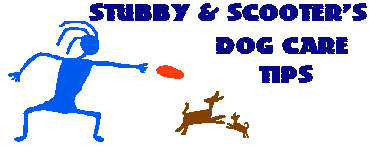  Since any pet is a member of the family you should try to make their care easy and enjoyable.
Bathing and brushing, exercise and most especially loving attention should be the normal
routine for all dogs. A little time set aside just for them each day will have many benefits for both the owner and the pet. Since any pet is a member of the family you should try to make their care easy and enjoyable.
Bathing and brushing, exercise and most especially loving attention should be the normal
routine for all dogs. A little time set aside just for them each day will have many benefits for both the owner and the pet.
Good care begins before you ever bring your new pet home. You will need food, sturdy food and water bowls, a collar, a leash, a brush, a comb, suitable toys to divert them from chewing on your shoes and other possessions, and an appropriately sized bed in a safe area of your home.
It is a good idea to make the first veterinary appointment as soon as possible after bringing your new puppy home if not before. The vet will want to assess the puppy's general overall health and start or continue their program of puppy shots. It is also nice to let your pet become acquainted with his/her vet early. If your your vet provides the service take them in and have them weighed periodically so not all associations are with pain and discomfort.
Proper diet and feeding is an important consideration. You may either use the dog food recommended by your vet or another popular brand. Puppies who are 8 to 12 weeks old need to have four meals a day. Puppies 3 to 6 months old need three meals a day. Puppies 6 months to 1 year old need two meals a day. When your pet is 1 year old, one meal a day is adequate. You may choose to have dry food available throughout the day and provide a small amount of canned food once a day. Water should always be handy and changed frequently. We all know that dogs love people food. If you share with them you should not encourage begging while you are eating your meal, give them large amounts of fat scraps, give them bones or let table replace more than 15% of their diet. By all means give them a balanced variety of table scraps. Dogs will eat cooked eggs, cooked veggies, and rice in addition to meat and gravies. Stubby's favorite table food treats are raw tomatos and dill pickles.
Make sure you have a warm, quiet place for your dog to rest and sleep. You can buy a dog bed or make one out of a cardboard box lined with newspapers and an old blanket or towel. Wash the bedding often. Our dogs start their lives with us in the hall bathroom. We remove everything they can chew on, place their bed behind the toilet which sounds odd but it's close to heating vent in the winter and is cool in the summer. We close them in "their bedroom" at night and while we are absent from the house and give them free access during the day. They have water and a small bowl of dry food. They also have a water dish outside. When they are older, housebroken and have less inclination to chew everything they have a cedar bed at our bedside.
  Housebreaking is a touchy subject with many differing approaches. What works best for us is taking them outside before putting them to bed, first thing in the morning and at regular intervals throughout the day. We also take them outside in the middle of the night if we get up yourselves. If we catch them squatting we clap loudly, give them a firm no and rush them outside. We clean up the spot and spray it with lysol. We always take them to the same spot and tell them to "go potty". They usually have the hang of it before they are 3 months old and will potty on command by the time they 6 months old if we are taking a car trip. Housebreaking is a touchy subject with many differing approaches. What works best for us is taking them outside before putting them to bed, first thing in the morning and at regular intervals throughout the day. We also take them outside in the middle of the night if we get up yourselves. If we catch them squatting we clap loudly, give them a firm no and rush them outside. We clean up the spot and spray it with lysol. We always take them to the same spot and tell them to "go potty". They usually have the hang of it before they are 3 months old and will potty on command by the time they 6 months old if we are taking a car trip.
Since we live in the desert and our yard is sand our dogs are bathed once a week. They are then brushed. We use this time to check for the corkscrew seed pods of the cranesbill that will bury themselves in the dogs skin if left untended and of course fleas and ticks. We also trim off the hair mats that Stubby gets behind his ears.
Chewing on forbidden items is discouraged with a loud clap, a firm no, and replacing the item with a chew stick or a pig ear strip. We teach our dogs just a few simple commands like stay, sit, down, no, and come. Scooter is just beginning to learn them. We reward them during training with treats like snausages and peanuttys.
One of the biggest dangers to dogs in the desert is overheating. We never leave the dogs alone in a vehicle with the windows up in spring, summer, or fall. They have plenty of shade in the yard from plants and trees and a doggie door into the screened porch when we are away. We have multiple "water stations" in the yard which they share with our ducks and geese. Another is rattlesnakes. Snakes will come into yards in inhabited areas but it is rare. All dogs should be kept in a yard or house and not allowed to roam free. If they are walked they should be on a leash. In most places this a law.
It is important to keep their shots current and get them licensed. Spaying and neutering are of course a personal decision but if a dog is not suited for breeding it's the best option. It is not very expensive and many places have programs help defray the cost. Ask your vet if there any available in your area.
Most of us will be able to see the obvious injuries especially if our pet is bleeding or limping. A good pet owner will also watch for less noticable signs and symptoms of problems. Symptoms to watch for include diarrhea, constipation, fever, shivering, runny nose, dry hot nose, runny or watery eyes, coughing, loss of appetite, vomiting, restlessness, an indication of pain, a general irritability, or just a feeling that the dog isn't acting right. It is better to discuss this things with the vet than let the problem persist until it can't be resolved.
  Some Do's and Don'ts Some Do's and Don'ts
Do provide lots of love and attention
Do make regular appointments with the vet
Do buy lots of toys to divert them
Do keep the gates closed and if necessary locked
Do buy them a collar and a name tag. Include a back-up phone number of a friend or family member in case you're away from home
Do read the labeling on the dog food you buy and buy brands with a minimum of fillers and other additives.
Do teach them manners around strangers
If you want to give them bones make sure they are large bones like soup bones or knuckle bones. These are much less likely to splinter. You can get them from the butcher in the meat department or you can even buy them in the pet food aisle. They are also available in pet stores.
Don't give them chocolate. Even small amounts can be toxic.
Don't use choke chain collars for everyday wear. They could get it caught and choke to death
Don't hit them. A firm no, a loud clap and your disapproval are often punishment enough
Don't leave them unattended around small children
Don't leave them unattended in vehicles
Don't let them roam free
Don't use items like Febreeze on their bedding. It may be safe for animals but how would you like it if they sprayed your bed with Lysol? Remember their nose is more sensitive than yours. I wash their bedding from time to time using hot water with a minimal amount of soap and then rinse twice.
Pet Insurance
Some pet illnesses can be catastrophic. Help defray the cost of your pet's major medical expenses.
An old man and his dog were walking along a country road, enjoying the scenery, when it suddenly occurred to the man that he had died.
He remembered dying, and realized, too, that the dog had been dead for many years. He wondered where the road would lead them, and continued
onward.
After a while, they came to a high, white stone wall along one side of the road. It looked like fine marble. At the top of a long hill, it was broken by a tall, white arch that gleamed in the sunlight. When he was standing before it, he saw a magnificent gate in the arch that looked
like mother of pearl, and the street that led to the gate looked like pure gold. He was pleased that he had finally arrived at heaven, and the
man and his dog walked toward the gate. As he got closer, he saw someone sitting at a beautifully carved desk off to one side.
When he was close enough, he called out, "Excuse me, but is this heaven?"
"Yes, it is, sir," the man answered.
"Wow! Would you happen to have some water?" the man asked.
"Of course, sir. Come right in, and I'll have some ice water brought right up." The gatekeeper gestured to his rear, and the huge gate began
to open. "I assume my friend can come in..." the man said, gesturing toward his dog.
But the reply was "I'm sorry, sir, but we don't accept pets."
The man thought about it, then thanked the gatekeeper, turned back toward the road, and continued in the direction he had been going. After another long walk, he reached the top of another long hill, and he came to a dirt road which led through a farm gate.
There was no fence, and it looked as if the gate had never been closed, as grass had grown up around it. As he approached the gate, he saw a man
just inside, sitting in the shade of a tree in a rickety old chair, reading a book.
"Excuse me!" he called to the reader. "Do you have any water?"
"Yeah, sure, there's a pump over there," the man said, pointing to a place that couldn't be seen from outside the gate. "Come on in and make yourself at home."
"How about my friend here?" the traveler gestured to the dog.
"He's welcome too, and there's a bowl by the pump," he said. They walked through the gate and, sure enough, there was an old-fashioned hand pump
with a dipper hanging on it and a bowl next to it on the ground. The man filled the bowl for his dog, and then took a long drink himself. When
both were satisfied, he and the dog walked back toward the man, who was sitting under the tree waiting for them, and asked, "What do you call
this place?" the traveler asked.
"This is heaven," was the answer.
"Well, that's confusing," the traveler said. "It certainly doesn't look like heaven, and there's another man down the road who said that place
was heaven."
"Oh, you mean the place with the gold street and pearly gates?"
"Yes, it was beautiful."
"Nope. That's hell."
"Doesn't it offend you for them to use the name of heaven like that?"
"No. I can see how you might think so, but it actually saves us a lot of time. They screen out the people who are willing to leave their best
friends behind."

Back to Mojaveolver Home Page


This page hosted by  Get your own Free Home Page
Get your own Free Home Page
|

![]()

![]()


